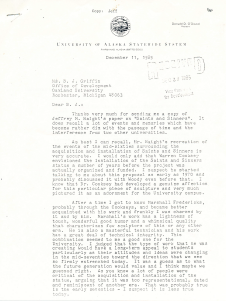Saints and Sinners
- Overview
- Saints and Sinners Come to OU
- Marshall Fredericks
- The Seven Saints and Sinners
- Proposed Sites for the Sculptures
- President O'Dowd on
Saints and Sinners - Bibliography
Overview
Saints and Sinners, by Marshall Fredericks, was Oakland University's first major exterior sculpture.
"I have long wanted to be able to display a major sculpture somewhere on the campus and now, finally, the dream can become a reality."
Donald O'Dowd, May 24, 1974
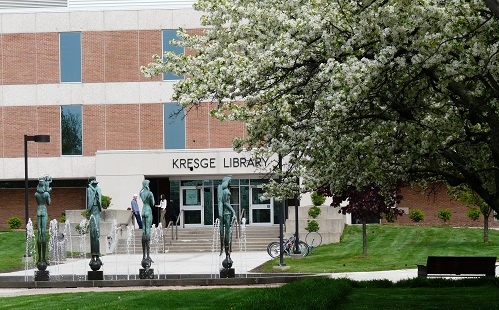
Ground Breaking: April 19, 1976
Dedication: October 22, 1976
Cost: $100,000 for the sculptures; $68,000 for other costs
Funding: the Josephine S. Gordon Foundation of Detroit gave $100,000 to commission the sculpture. Additional money for the fountain was to come from capital outlay funds, the Irene C. Wellock trust, and the University's President Club, a group of individuals supporting the University and its programs.
Consultant: Johnson, Johnson and Ray, Inc., Ann Arbor, MI
Construction: Wyden Construction, Inc., Southgate, MI
Square Footage: 25 x 50 foot oval, 7 bronze pieces, each 9' 6" high
Sculptor: Marshall Fredericks (1908-1998)
History: Craig Redfern, member of Commuter Council, staged a contest for students to nickname the fountain. (Oakland Sail, Sept. 22, 1976)
Saints and Sinners: The Story of their Acquisition
Jeffrey Haight (November 12, 1985)
As students scamper off to class in their quest for knowledge, their paths lead them past the sculpture in front of Kresge Library. With little time to spare, they have but a brief moment or two in which they cast a glance at the figures as if showing them a form of deference. Yet students do find the time to eventually stop and view the sculptures with a curious eye, hoping to unlock their meaning. The fact that they have intrigued so many would please those responsible for obtaining them since it was
their belief that the sculpture would be well received by the students now and in the years to come. The sculpture entitled "Saints and Sinners" was obtained to provide the students with an appealing form of art which they could appreciate, while enhancing the picturesque landscape of the campus.
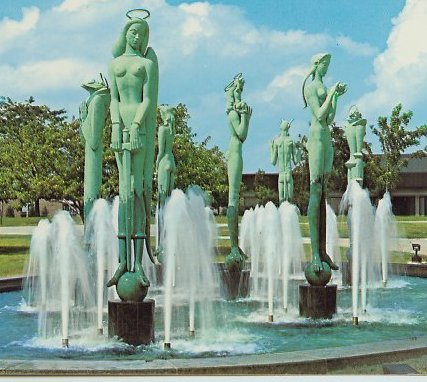
Photo published by: Ruth Graham, Grosse Pointe Woods, MI
The "Saints and Sinners" sculpture, which is located on Kresge Library's western entrance, is the creation of world-renowned sculptor Marshall Fredericks. Fredericks, who studied under Carl Milles in Stockholm and later joined his staff at Cranbrook, shows some of Milles influence in this and other works. Although many students feel that the seven figures bear some form of a religious or social message, Marshall Fredericks would be the first to tell you that there is none. According to Fredericks, "these figures are very light-hearted and were designed to be humorous and pleasant with no hidden social message." 1 He felt that they were quite suitable to the taste of more youthful college audience which could appreciate and admire its simplicity in a tense academic environment. Although first interpreted by the students as "resembling certain administration and faculty members.2
, Fredericks offers a somewhat differing interpretation. To him, the seven figures represent "good, evil, temptation, knowledge of good and evil, a saint of the church, a mother and child, and a warrior saint."3 Upon closer examination of the facial expressions and gestures, its humorous style becomes apparent to even the most inexperienced of critics. The rather imposing and streamlined figures stand approximately ten feet in height and are made of cast bronze.Although the seven figures have made Oakland their home, they were not originally commissioned for the university. In fact, the "Saints and Sinners" figures were not a commissioned work at all, but a personal project of Fredericks. For nearly thirty years, whenever he wasn't working on a commissioned work, Fredericks would turn his attention towards the figures. Each one was worked on individually and was designed "from smaller models of the sculpture made shortly after World War.4 Over the years, the figures had been carefully stored in Fredericks' studio. They were first brought to the attention of Oakland University through the good services of Doctor Warren B. Cooksey.
Dr. Cooksey, who had been active in the affairs of Oakland through his services in the Oakland University President's Club, became intrigued with the idea of bringing the sculpture to the university. Dr. Cooksey felt that the funds to purchase "Saints and Sinners" could be obtained from the Josephine E. Gordon Foundation of which he was a member. In a memorandum which was sent to Oakland University President Donald D. O'Dowd on October 5, 1973, he continued to express his interest in obtaining the figures. He informed President O'Dowd that the Josephine E. Gordon Foundation had "a source of funds (from interest charges) which they did not anticipate."5
The Foundation, which provides funds for educational, charitable, religious, scientific and literary purposes for the public welfare, discussed the matter with Dr. Cooksey.6 To Dr. Cooksey's pleasure, the Foundation's Board approved a donation of $100,000 to Oakland University for the purchase of "Saints and Sinners." Oakland University officially accepted this generous donation on June 26, 1974, as President O'Dowd's resolution to accept this generous donation before the Board of Trustee's was adopted. In addition, the Board also authorized "the expenditure of funds granted by the Oakland University Foundation to install the sculptures in an appropriate and aesthetically pleasing manner on the Oakland University Campus."7
Perhaps one of the most interesting of problems posed by the "Saints and Sinners" sculpture was where its location on campus should be. There were several sites which were first proposed, which prompted the University to employ the consulting engineering firm of Johnson, Johnson, & Roy, Inc., to study the feasibility of each site. The Ann Arbor firm's findings had led to a narrowing of the field to three sites for consideration: the Library mall site, the Oakland Center site, and the Beer Lake site. In choosing between the three sites, there were three basic criteria which had to be taken into consideration. These three, in their order of importance, were "the cost and ease of installation, easy access and exposure to public viewing, and easy access to the water supply." 8 Of the three sites, the Library mall location proved to be the most practical since its costs were relatively moderate and its location guaranteed it easy access to water and exposure to public viewing. Reason for the unacceptability of the other sites extended beyond expense and into other areas. For example, Beer Lake would have to contend with the problem of ice in the winter, while the Oakland Center site was under consideration for the construction of a new building.9 With these factors taken into consideration, the decision to locate the sculpture in front of Kresge Library was made with relative ease.
The final task of the project involved the construction of the fountain and pool setting for the figures. The funds for such an undertaking were made available to the university the form of a bequest from the estate of Irene C. Wellock for $80,000 and an additional $15,000 was provided by the Oakland University Foundation. The contract for the project was awarded to the Wydan Construction company whose budget, as reviewed by Johnson, Johnson, Roy, reads as follows:
| Architects Fees | $5,500 | ||
| Construction: | |||
| Wydan Construction, Inc. | $59, 450 | ||
| Inspection & Engineering | $1,250 | ||
| Contingency | $1,800 | 10 | |
The construction of the fountain was completed in 1976 with no major problems encountered. Apparently, the only deviation from the original design was to use polished marble instead of sawed marble since the polished marble was by far more complimentary and agreeable with the sculptures' other features. Installation of the "Saints and Sinners" figures was done in ample time for the dedication ceremony which took place on October 22, 1976. The ceremony which was closed to the public was attended by those individuals and organizations whose contributions and dedication to the "Saints and Sinners" project made possible the attainment of Oakland University's first major sculpture. The fifty individuals who were in attendance that day were mostly members of the following organizations:
Josephine E. Gordon Foundation
Oakland University's Board of Trustees
Executive Committee of the President's Club
The University President's Administrative Group
Executive Trustees of the Oakland University Foundation11
As the "Saints and Sinners" sculpture nears its tenth anniversary at Oakland University (1976-1986), the figures have become as much a part of the campus scene as Beer Lake, soccer or Saga. The contributions of those individuals whose efforts rewarded the university with its first major sculpture have not been lost upon the students. At times, their concern for the well-being of the figures has been shown that it knows no bounds. After all, how often do figures in other sculptures receive mittens and scarves for those cold winter nights?
References
1. Telephone interview with Marshall Fredericks, Sculptor (Saints and Sinners), 17 September 1985.
2. "Five sculptors of the Midwest," National Sculpture Review, Spring, 1976, p. 1.
3. Kathy Parrish, "Saints and Sinners find a home," In Touch, January 1977, p. 1
4. Telephone interview with Marshall Fredericks, Sculptor (Saints and Sinners), 17 September 1985
5. Memorandum to Oakland University President Donald D. O'Dowd from Glenn Brown, Assistant President for Campus Development, 5 October 1973. Oakland University Archives.
6. Marianna O. Lewis, ed., The Foundation Directory, 4th ed. (New York: Columbia University Press, 1971), p. 181
7. Minutes of the Meeting of the Board of Trustees, Oakland University, Rochester, Michigan, 26 June 1974. See also Oakland University Foundation Executive Trustees Meeting (July 2, 1974) for approval of purchase of the base.
8. Telephone interview with George Karas, Oakland University Engineer, 29 October 1985.
9. Ibid.
10. Memorandum to Dr. Kenneth H. Coffin, Vice President for Campus and Student Affairs, from George Karas, Oakland University Engineer, 9 February 1976. Oakland University Archives.
11. Telephone interview with B. J. Griffin, Oakland University Development Office, 30 October 1985.
Acknowledgments
To those individuals whose cooperation and assistance was of great value in the research of "Saints and Sinners."
Marshall Fredericks, B.J. Griffin, Marion Bunt, George Karas, John B. Cameron, W. Patrick Strauss, Robert G. Gaylor
The critical advice of these people made this a much better study than it originally was.
---
Used with permission of Jeffrey M. Haight
J. Haights was a student at Oakland who wrote this paper
for his senior history project
---
Marshall Fredericks
Marshall Fredericks (1908-1998) is a world-renowned American sculptor who studied under Carl Milles in Stockholm and later joined his staff at the Department of Sculpture of the Cranbrook Academy of Art. Fredericks had a studio in Royal Oak, where he produced many sculptures for the Detroit area, including the Spirit of Detroit.
Fredericks worked on the seven Saints and Sinners figures over a long period of time in his studio. It was his doctor, Warren Cooksey, who arranged to have them used for a fountain at Oakland University.
Fredericks was happy to have his sculptures at Oakland. He thought that the "figures are youthful - something students can relate to" and argued that it was important for a university campus to have art and humor.1
For more information:
Marshall Fredericks Sculpture Museum
- View collections on Google Art Project
Notes
1. Kathy Parrish. "Saints and Sinners' find a home." In-Touch: A publication for Oakland University Alumni (January, 1977), p. 1,4
The Seven Saints and Sinners
The seven bronze figures represent good, evil, temptation, knowledge of good and evil, a saint of the church, a mother and child, and a warrior saint. They are all balanced atop small orbs. As a whole they seem to be a parody of the Seven Deadly Sins.
Mother and Child
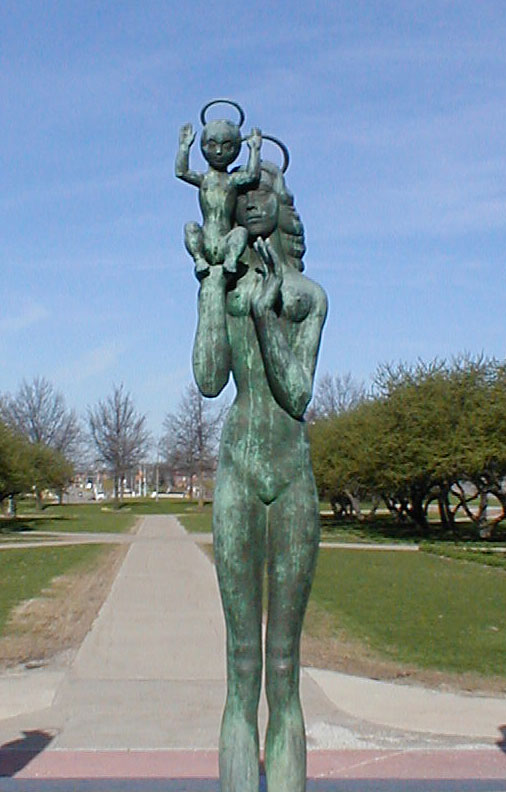
The Pious Monk or Saint of the Church
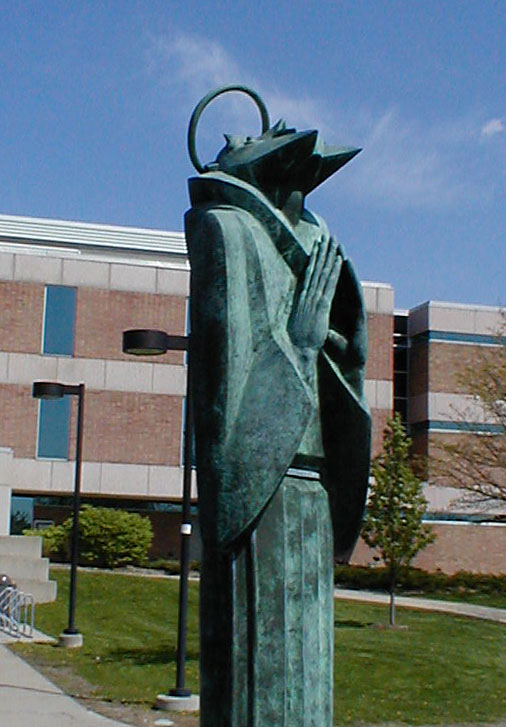
Eve or Knowledge of Good and Evil

Evil

The Good Influence
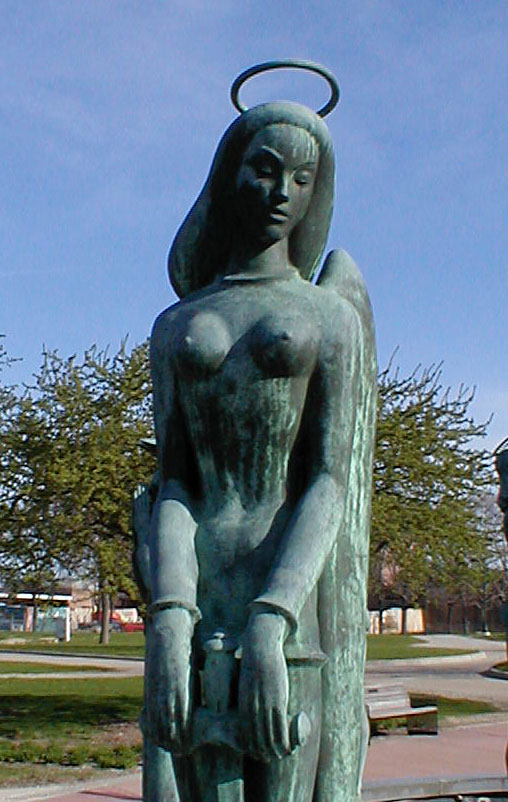
The Temptation

The Warrior

Proposed Sites for the Sculptures
Several sites on campus were suggested for the sculptures. The library was chosen because of its location, which would make the sculptures easily visible to the public, and because of the moderate cost of their installation on the site.
Beer Lake

Varner Hall
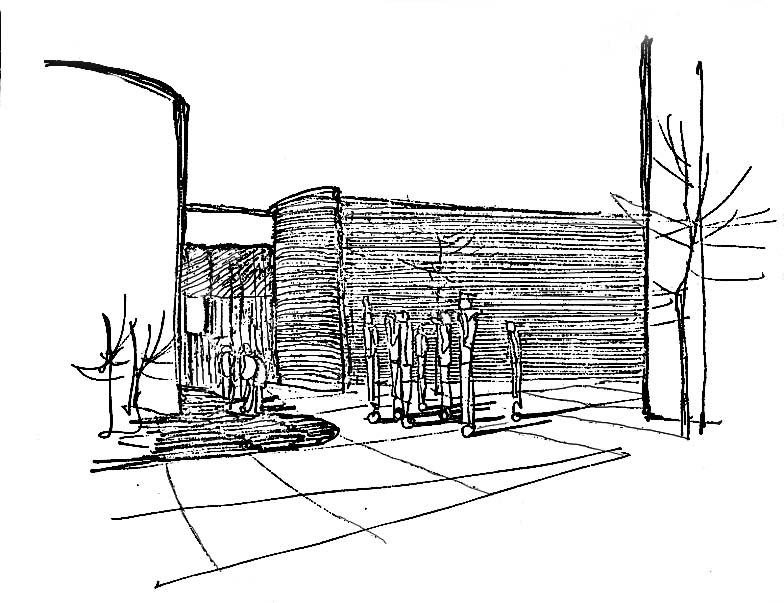
Library - East side
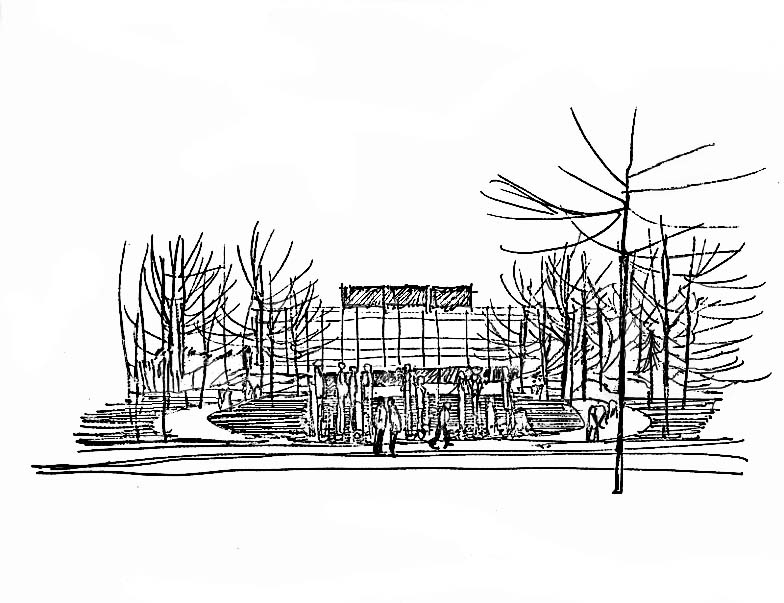
Library - West side
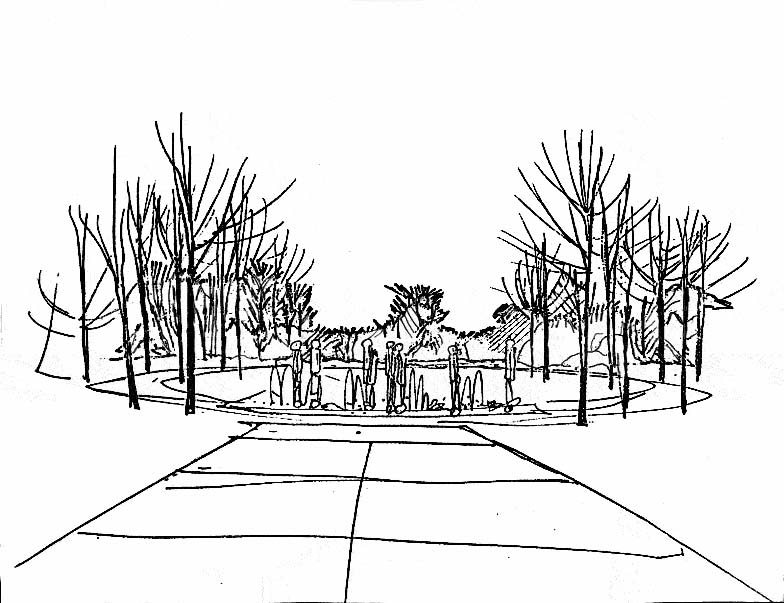
Foundation Hall
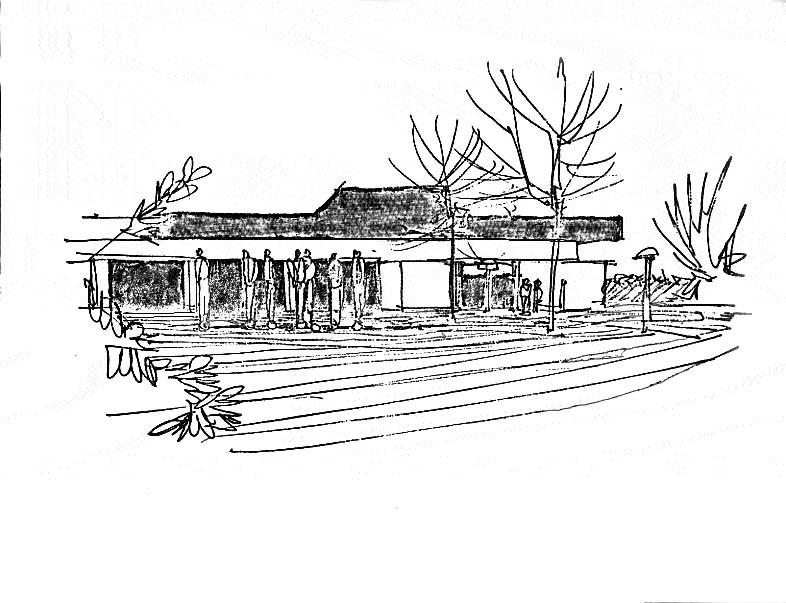
Sketches: Johnson, Johnson, & Roy
Restored by Rob Burns
President O'Dowd on Saints and Sinners
In a 1985 letter to his former OU Secretary B. J. Griffin, former Oakland University President Donal O'Dowd explained:
"Marshall's work has a lightness of touch, wonderful good humor and a whimsical quality that characterized few sculptors of this or any other era. He is also a masterful technician and his work has a great deal of technical integrity. This combination seemed to be a good one for the University."
He goes on to recall his personal experience with Marshall Fredericks and the circumstances that brought Saints and Sinners to campus.
Letter from Donald O'Dowd to B. J. Griffin, December 11, 1985
[Used with permission of Donald D. O'Dowd.
A copy of this letter was sent to Jeffrey Haight who supplied it for this page.]
Bibliography
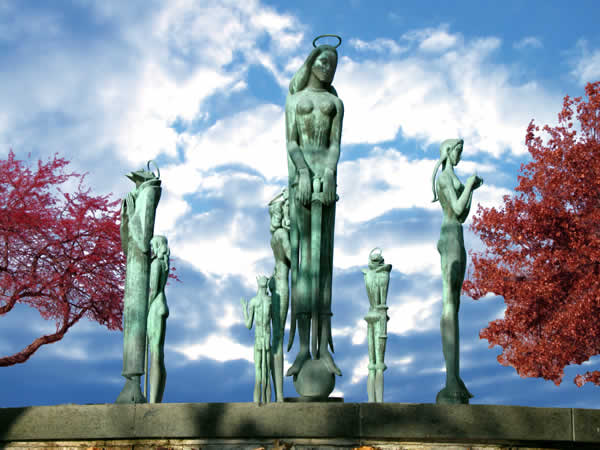
Photo courtesy of Robert Slater
Publications on Fredericks
A.I.A. fine arts medal for 1952. por (p. 20) American Institute of Architects Journal 18: 3 July 1952
Architecture and sculpture. American Institute of Architects Journal 18: 6-8 July '52
Awarded AIA fine arts medal. por Magazine of Building (house and home edition) 1:1963 June '52
Beyond the graven images: sculptor's campus presence stirs debate after death, by Jenni Glenn. Michigan Daily, 9-23-99.
Five sculptors of the Midwest. National Sculpture Review 27 no. 1: 11 Spring 1978 il: Saints and sinners fountain
Fountain creator passes away, by Pam Hendrix. Oakland Post, April 8, 1998
Levi Barbour memorial fountain. M. Fredericks, sculptor. il Pencil Points 18:92-5 Fall 1939
'Man of the Expanding Universe' : Marshall M. Fredericks fountain restored and rededicated at the State-Department-Building in Washington, DC." Sculpture Review 45, no. 4 (SPR 1997): 35
Marshall Fredericks. IN: Brookgreen Gardens Sculpture, by Robin R. Salmon. Brookgreen, SC: Brookgreen Gardens, 1993. v. 2, pp. 126-137, 219.
Marshall Fredericks honored (Sun worshiper). Sculpture Review 43, no. 4 (WIN 1995): 33
Marshall Fredericks: A Monumental Talent, by Nancy Sajdak Manning. Michigan History Magazine vol. 96 no. 2 (March/April 2012): 15–21.
Marshall M. Fredericks, Sculptor. Edited by Suzanne P. Fredericks. Marshall M. Fredericks Sculpture Museum, 2003.NSS presents awards. National Sculpture Review 31 no. 2: 27 Summer 1982
The Outdoor Museum: Magic of Michigan's Marshall M. Fredericks, by Marcy Heller Fisher and illustrated by Christine Collins Woomer (Wayne State University Press, 2001).
Portrait. Architectural Record 112: 11 July 1952
Public sculpture, the talk of the town. M. Lantz. National Sculpture Review 31 no. 1: 22-3 Spring 1982 il: model for Mother Bear and Baby (2)
Recent dedications. National Sculpture Review 27 no. 1:20 Spring 1978 il: Henry Ford I memorial
'Saints and Sinners' find a home, by Kathy Parrish, In Touch, January 1977.
Sculptor to the people. E. W. Watson. il. por. American Artist 18:36-41+ Summer 1954
"Sculpture was local, images were global," by Patricia Montermurri. Detroit Free Press, April 6, 1998
Marshall Fredericks' Papers at Saginaw Valley State University
Marshall Fredericks Digital Archive
(includes items related to the Saints and Sinners Fountain)
Reproductions of Fredericks sculpture
Acrobat. Pencil Points 20: 661 October 1939
Baboon Fountain. Pencil Points 20: 662-3 October 1939
Barbour fountain. National Sculpture Review 22 no. 4:24 Winter 1973-74
Bas relief for Beaumont Hospital, Royal Oak, Michigan. Architectural Record 119: 28 May 1956
Bear. Royal Architectural Institute of Canada Journal 33:229 June 1956
Bear. National Sculpture Review 18 no. 2: 9 Summer 1969
Bear and boy. Architectural Forum 100: 118 June 1954
Bear and boy. Arts & Architecture 72: 23 May 1955
Childhood friends (bronze). Sculpture review 35:11 Spring 1986
Eaton manufacturing medal. National Sculpture Review 20, no. 3: 17 Fall 1971
Flying geese. National Sculpture Review 30 no.4:21 Winter 1981-82
Flying gulls. National Sculpture Review 19 no. 2: 14 Summer 1969
Friendly frog. National Sculpture Review 20, no. 4:20 Winter 1971-72
Gazelle. National Sculpture Review 21 no. 3: 6 Fall 1972
Gazelle (bronze, 1972). Sculpture Review 40 no.2: 27 1991
Gazelle medal (1977). National Sculpture Review 30 no. 1: covs Spring 1981 (2 views)
Juggler. Pencil Points 20: 661 October '39
Levi Barbour memorial fountain. M. Fredericks, sculptor. il Pencil Points 18:92-5 Fall 1939
Man and the expanding universe (bronze, nickel, glass, Mosaic and granite). Sculpture Review 32 no. 4:13 Winter 1984-84
Ohio Union Building panels. National Sculpture Review 21, no. 2: 19 Summer 1972
Persephone, goddess of spring. National Sculpture Review 22 no. 3:14 Fall 1973
Portrait of a Japanese. Cleveland Museum Bulletin 18:95 May '31 Art Digest 5:5 June 1931
Portraits of farm animals. Magazine of Art 34:435 October 1941
Sisters. Pencil Points 20: 261-2 May 1939
Torso of a dancer. Magazine of Art 32:653 November 1939
Torso of a dancer. Pencil Points 20: 664 October 1939
Warrior saint. National Sculpture Review 25 no. 4: 11 Winter 1976-77
In providing access to its collections, the Oakland University Archives and Special Collections acts in good faith. Despite the safeguards in place, we recognize that mistakes can happen. If you find on our website or in a physical exhibit material that infringes on an individual’s privacy, please contact us in writing to request the removal of the material. Upon receipt of valid complaints, we will temporarily remove the material pending an agreed solution.





